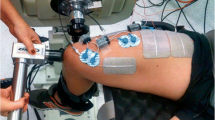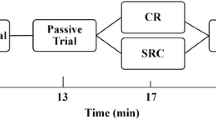Abstract
Introduction
Roller massage (RM) has been reported to reduce pain associated with exercise-induced muscle soreness and increase range of motion without force or activation impairments. The objective was to examine RM effects on evoked pain and contractile properties.
Methods
Twelve men received three sets of 30-s RM at a perceived discomfort level of 7/10 on a visual analogue scale on the ipsilateral (IPSI-R) stimulated plantar flexors (PF), contralateral PF (CONTRA-R), Sham (light rolling on stimulated PF), or Control. At pre-test, post-test, and 5-min post-test, they received evoked maximal twitch, tetanus, and 70% maximal tetanic stimulation, and performed a maximal voluntary isometric contraction (MVIC). Data analysis included perceived pain and contractile properties.
Results
The 70% tetanus illustrated significant 9–10% increases in pain perception with Sham and Control at post- and 5-min post-test, respectively (p < 0.01). There was no pain augmentation with IPSI-R and CONTRA-R. There were no main effects or interactions for most contractile properties. However, MVIC force developed in the first 200 ms showed 9.5% (p = 0.1) and 19.1% (p = 0.03) decreases with IPSI-R at post-test and 5-min post-test.
Conclusion
Data suggest that RM-induced neural inhibition decreased MVIC F200 and nullified the testing-induced increase in evoked pain associated with 70% tetanic stimulation.







Similar content being viewed by others
Abbreviations
- ANOVA:
-
Analysis of variance
- CONTRA-R:
-
Contralateral plantar flexors rolling massage
- DOMS:
-
Delayed onset muscle soreness
- ES:
-
Effect size
- F200:
-
Peak force exerted within 200 ms of the maximum voluntary isometric contraction
- IPSI-R:
-
Ipsilateral plantar flexors rolling massage
- MVIC:
-
Maximum voluntary isometric contraction
- PF:
-
Plantar flexors
- PPT:
-
Pain pressure threshold
- RM:
-
Roller massager
- VAS:
-
Visual analogue scale
References
Aboodarda SJ, Spence AJ, Button DC (2015) Pain pressure threshold of a muscle tender spot increases following local and non-local rolling massage. BMC Musculoskeletal Disorders 16:265. doi:10.1186/s12891-015-0729-5
Avela J, Kyrolainen H, Komi PV, Rama D (1999) Reduced reflex sensitivity persists several days after long-lasting stretch-shortening cycle exercise. J Appl Physiol 86(4):1292–1300
Barnes MF (1997) The basic science of myofascial release. Morphologic change in connective tissue. J Body Mov Ther 1:231–238
Behm DG, Sale DG (1994) Voluntary and evoked muscle contractile characteristics in active men and women. Can J Appl Physiol 19(3):253–265
Behm DG, St-Pierre DM (1997a) Effects of fatigue duration and muscle type on voluntary and evoked contractile properties. J Appl Physiol 82(5):1654–1661
Behm DG, St-Pierre DM (1997b) Fatigue characteristics following ankle fractures. Med Sci Sports Exerc 29(9):1115–1123
Behm DG, St-Pierre DMM (1998) Fatigue mechanisms in trained and untrained plantar flexors. J Strength Cond Res 12(3):166–172
Behm DG, Reardon G, Fitzgerald J, Drinkwater E (2002a) The effect of 5, 10, and 20 repetition maximums on the recovery of voluntary and evoked contractile properties. J Strength Cond Res 16(2):209–218
Behm DG, Whittle J, Button D, Power K (2002b) Intermuscle differences in activation. Muscle Nerve 25(2):236–243
Behm DG, Peach A, Maddigan M, Aboodarda SJ, DiSanto MC, Button DC, Maffiuletti NA (2013) Massage and stretching reduce spinal reflex excitability without affecting twitch contractile properties. J Electromyogr Kinesiol 23(5):1215–1221. doi:10.1016/j.jelekin.2013.05.002
Bradbury-Squires DJ, Noftall JC, Sullivan KM, Behm DG, Power KE, Button DC (2015) Roller-massager application to the quadriceps and knee-joint range of motion and neuromuscular efficiency during a lunge. J Athl Train 50(2):133–140. doi:10.4085/1062-6050-49.5.03
Cleland CL, Rymer W (1990) Neural mechanisms underlying the clasp-knife reflex in the cat I Characteristics of the reflex. J Neurophysiol 64(4):1303–1318
Cohen J (1988) Statistical power analysis for the behavioural sciences. L. Erbraum Associates, Hillside N.J. pp 12–65
Duncan GH, Bushnell MC, Lavigne GJ (1989) Comparison of verbal and visual analogue scales for measuring the intensity and unpleasantness of experimental pain. Pain 37:295–303
Edman KA, Josephson RK (2007) Determinants of force rise time during isometric contraction of frog muscle fibres. J Physiol 580(Pt.3):1007–1019. doi:10.1113/jphysiol.2006.119982
Falkensteiner M, Mantovan F, Muller I, Them C (2011) The use of massage therapy for reducing pain, anxiety, and depression in oncological palliative care patients: a narrative review of the literature. ISRN Nurs 2011:929868. doi:10.5402/2011/929868
Halperin I, Aboodarda SJ, Button DC, Andersen LL, Behm DG (2014) Roller massager improves range of motion of plantar flexor muscles without subsequent decreases in force parameters. Int J Sports Phys Ther 9(1):92–102
Han SC, Harrison P (1997) Myofascial pain syndrome and trigger-point management. Reg Anesth 22(1):89–101
Kutner JS, Smith MC, Corbin L, Hemphill L, Benton K, Mellis BK, Beaty B, Felton S, Yamashita TE, Bryant LL, Fairclough DL (2008) Massage therapy versus simple touch to improve pain and mood in patients with advanced cancer: a randomized trial. Ann Intern Med 149(6):369–379
Lund I, Ge Y, Yu LC, Uvnas-Moberg K, Wang J, Yu C, Kurosawa M, Agren G, Rosen A, Lekman M, Lundeberg T (2002) Repeated massage-like stimulation induces long-term effects on nociception: contribution of oxytocinergic mechanisms. Eur J Neurosci 16(2):330–338
MacDonald GZ, Penney MD, Mullaley ME, Cuconato AL, Drake CD, Behm DG, Button DC (2013) An acute bout of self-myofascial release increases range of motion without a subsequent decrease in muscle activation or force. J Strength Cond Res 27(3):812–821. doi:10.1519/JSC.0b013e31825c2bc1
MacDonald GZ, Button DC, Drinkwater EJ, Behm DG (2014) Foam rolling as a recovery tool after an intense bout of physical activity. Med Sci Sports Exerc 46(1):131–142. doi:10.1249/MSS.0b013e3182a123db
Maffiuletti NA, Aagaard P, Blazevich AJ, Folland J, Tillin N, Duchateau J (2016) Rate of force development: physiological and methodological considerations. Eur J Appl Physiol. doi:10.1007/s00421-016-3346-6
Melzack R, Wall PD (1965) Pain mechanisms: a new theory. Science 150(3699):971–979
Mense S (2000) Neurobiological concepts of fibromyalgia–the possible role of descending spinal tracts. Scand J Rheumatol Suppl 113:24–29
Moayedi M, Davis KD (2013) Theories of pain: from specificity to gate control. J Neurophysiol 109(1):5–12. doi:10.1152/jn.00457.2012
Morelli MC, Chapman C, Sullivan S (1999) Do cutaneous receptors contribute to changes in the amplitude of the H-reflex during massage? Electromyogr Clinic Neurophysiol 39:441–447
Okamoto T, Masuhara M, Ikuta K (2014) Acute effects of self-myofascial release using a foam roller on arterial function. J Strength Cond Res 28(1):69–73. doi:10.1519/JSC.0b013e31829480f5
Pearcey GE, Bradbury-Squires DJ, Kawamoto JE, Drinkwater EJ, Behm DG, Button DC (2015) Foam rolling for delayed-onset muscle soreness and recovery of dynamic performance measures. J Athl Train 50(1):5–13. doi:10.4085/1062-6050-50.1.01
Pierrot-Deseilligny E, Burke D (2005) The circuitry of the human spinal cord: its role in motor control and movement disorders Cambridge: Cambridge University Press Price pp 385–411
Price DD, McGrath PA, Rafii A, Buckingham B (1983) The validation of visual analogue scales as a ratio scale measures for chronic and experimental pain. Pain 17:45–56
Pud D, Granovsky Y, Yarnitsky D (2009) The methodology of experimentally induced diffuse noxious inhibitory control (DNIC)-like effect in humans. Pain 144(1–2):16–19. doi:10.1016/j.pain.2009.02.015
Rutherford OM, Jones DA, Round JM (1990) Long-Lasting unilateral muscle wasting and weakness following injury and immobilisation. Scand J Rehabil Med 22:33–37
Schleip R (2003a) Fascial plasticity- a new neurobiological explanation: Part 2. J Bodywork Movement Therapies 7(2):104–116
Schleip R (2003b) Fascial plasticity- a new neurobiological explanation: Part I. J Bodywork Movement Therapies 7(1):11–19
Sigurdsson A, Maixner W (1994) Effects of experimental and clinical noxious counterirritants on pain perception. Pain 57(3):265–275
Sullivan KM, Silvey DB, Button DC, Behm DG (2013) Roller-massager application to the hamstrings increases sit-and-reach range of motion within five to ten seconds without performance impairments. Int J Sports Phys Ther 8(3):228–236
Vaughan BMP (2014) Immediate changes in pressure pain threshold in the iliotibial band using a myofascial (foam) roller. Int J Ther Rehab 21(12):569–574. doi:http://dx.doi.org/10.12968/ijtr.2014.21.12.569
Weerapong P, Hume PA, Kolt GS (2005) The mechanisms of massage and effects on performance, muscle recovery and injury prevention. Sports Med 35(3):235–256
Zainuddin Z, Newton M, Sacco P, Nosaka K (2005) Effects of massage on delayed-onset muscle soreness, swelling, and recovery of muscle function. J Athl Train 40(3):174–180
Acknowledgements
The Natural Science and Engineering Research Council of Canada (NSERC) and a MITACS Accelerate grant financially supported this study. We would like to acknowledge the contributions of Dr. Thamir Alkanani for his organization and preparation of the laboratory and equipment.
Author information
Authors and Affiliations
Corresponding author
Ethics declarations
Conflict of interest
There are no conflicts of interest of the authors with the information contained within the manuscript.
Additional information
Communicated by Olivier Seynnes.
Rights and permissions
About this article
Cite this article
Cavanaugh, M.T., Döweling, A., Young, J.D. et al. An acute session of roller massage prolongs voluntary torque development and diminishes evoked pain. Eur J Appl Physiol 117, 109–117 (2017). https://doi.org/10.1007/s00421-016-3503-y
Received:
Accepted:
Published:
Issue Date:
DOI: https://doi.org/10.1007/s00421-016-3503-y




